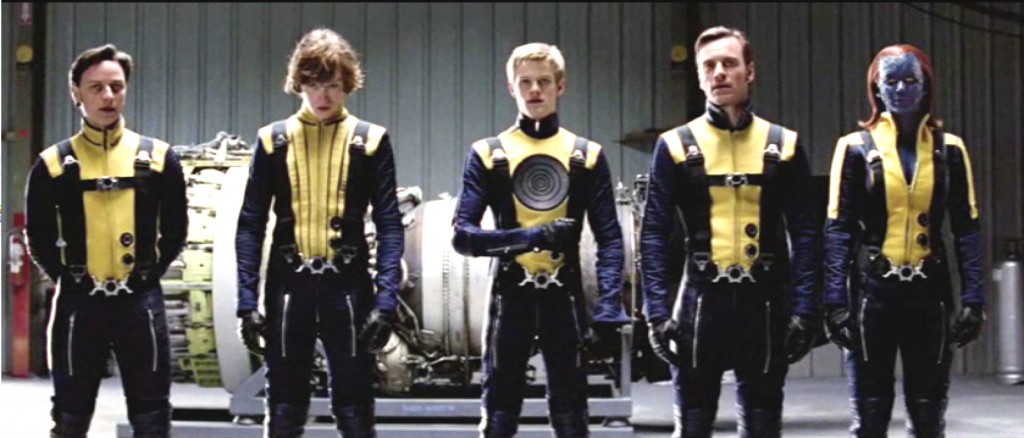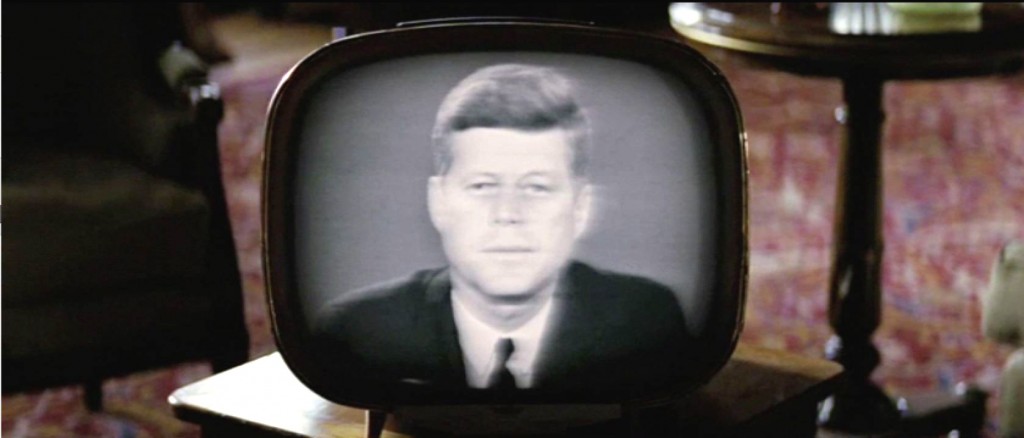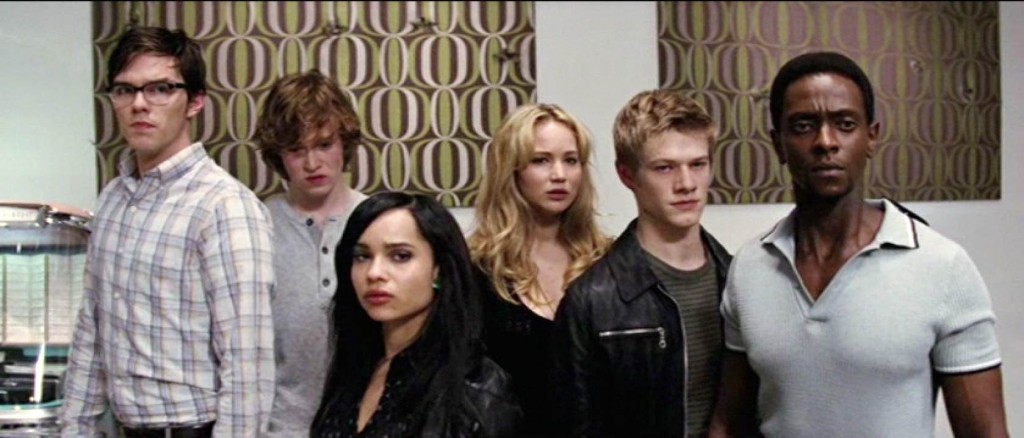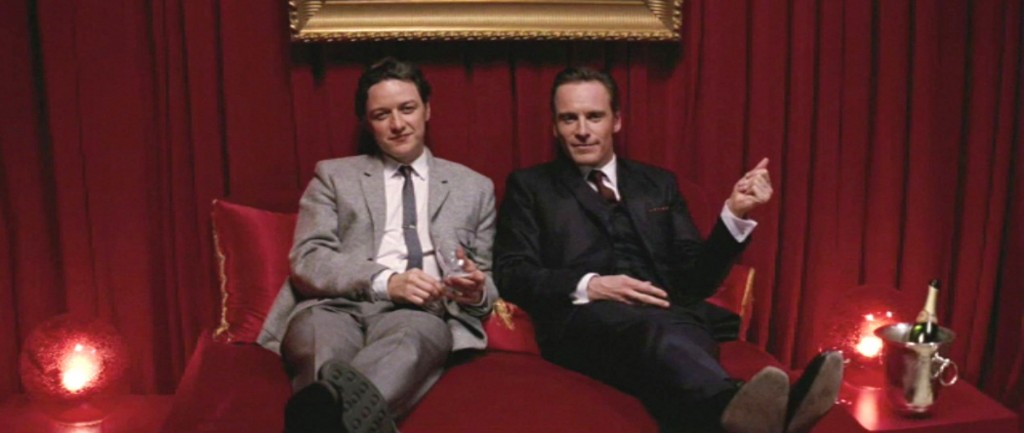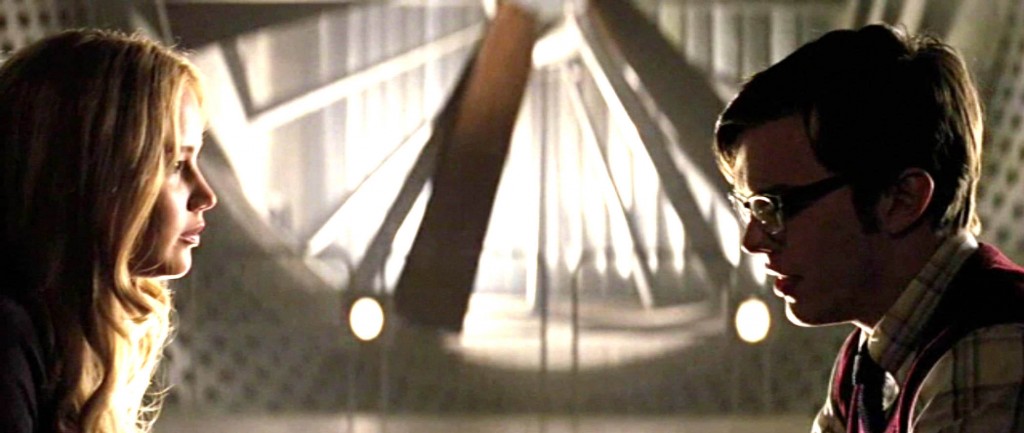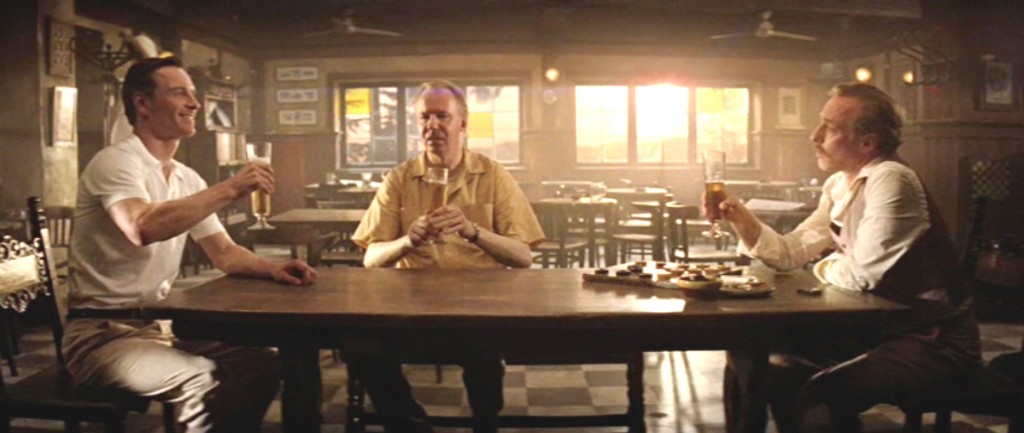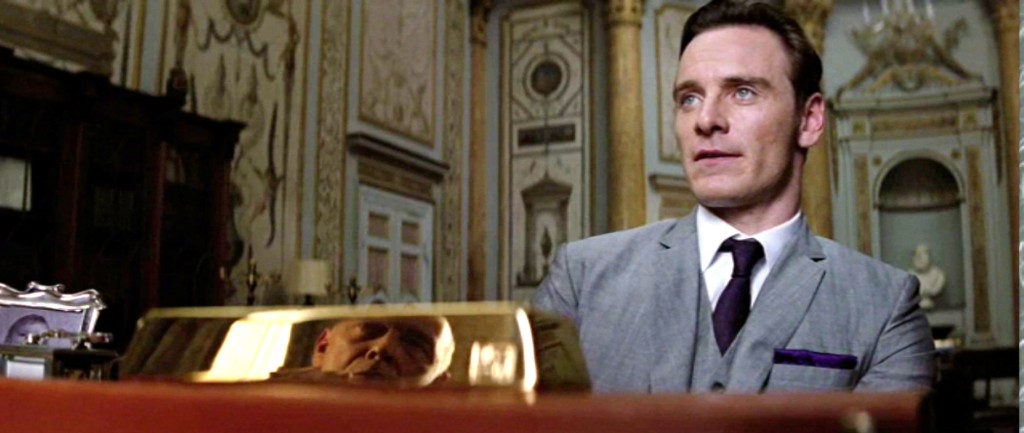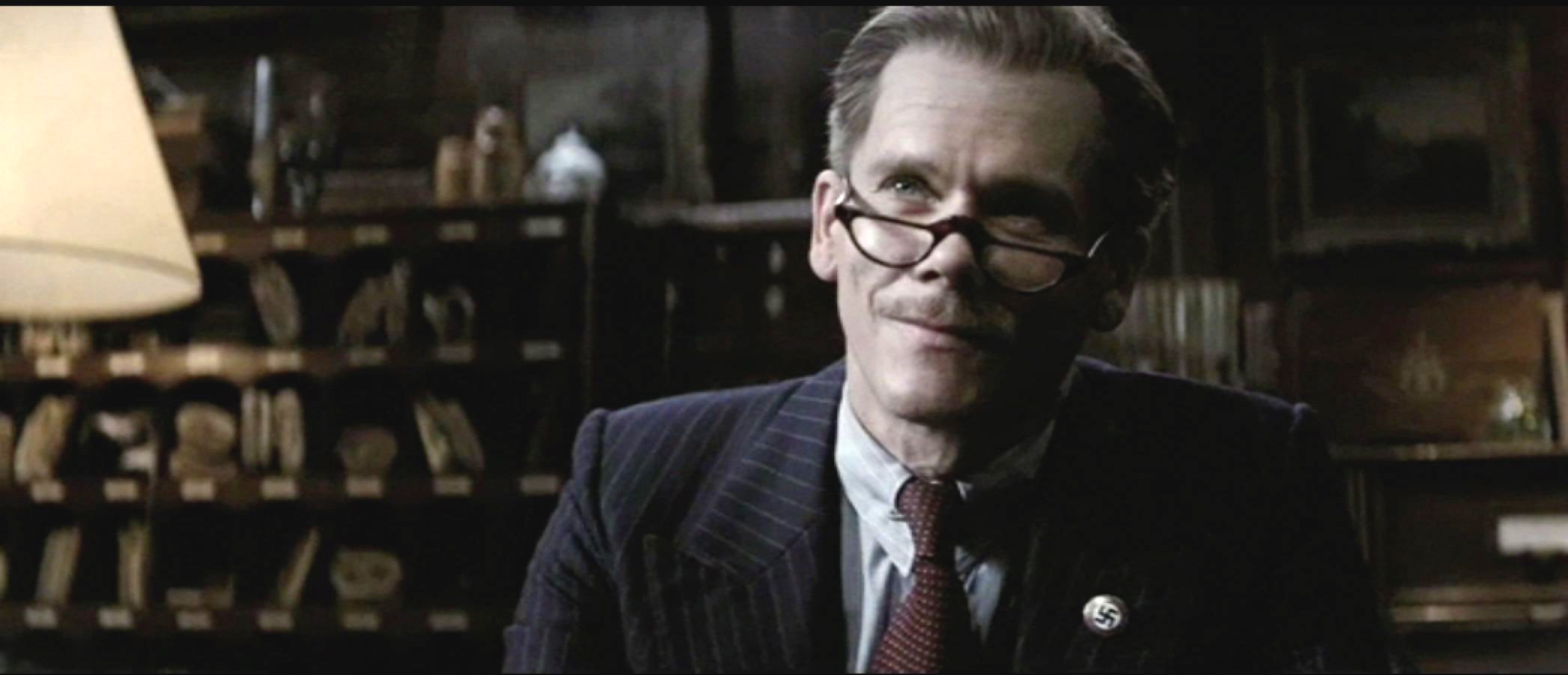X-Men: First Class part 11
The most striking, most unusual feature of the screeplay for X-Men: First Class is that it does not have a traditional end-of-second-act low point. In the typical superhero narrative, the story is: villain appears, superhero fights, villain triumphs, superhero comes back from defeat. That doesn’t happen here, because First Class, lest we forget, is a romance. The romantic comedy goes: boy meets girl, boy loses girl, boy gets girl back, but a straight romance doesn’t need a happy ending, and in fact can have a tragic ending, as in Romeo and Juliet or The Fly. In the romantic tragedy, the two leads want to be together but cannot — the forces arrayed against their union are too great. The forces arrayed against Erik and Xavier are all internal, and deal with their past and upbringing, irreconcilable questions of identity and personality. Erik cannot wake up in the morning and no longer be a persecuted Jew, and Xavier, for all his psychic power, cannot imagine life in Erik’s shoes, because he’s always had everything he needs. If they could change, if they could reconcile their differences (that’s why the movie spent the first act underlining those differences), they could stay together and save the world, but the narrative drives them irrevocably toward breakup and tragedy.
So what is the structure of First Class? I would say it’s: Act I, Erik and Xavier head on a path toward each other with Shaw as their common enemy, culminating in their meeting; Act II, Erik and Xavier pursue Shaw together and fall in love through the action of doing so, culminating in the raid on the Russian general’s house; Act III, a retreat to more internal matters as Xavier attempts to temper Erik’s anger with love while he trains his recruits; and Act IV, where Erik’s and Xavier’s relationship is put to the test: can they work together, save the world and be happy, or will the polar opposites of their pasts hinder their efforts and tear them apart, simultaneously bringing the end of the world? (“The end of the world” is an overused trope in superhero narratives — hell, a lot of narratives — but when it’s tied to a love story it become elevated; a romantic breakup often does feel like the end of the world, First Class merely literalizes it.)
X-Men: First Class part 10
As the fantastic merges with the historic, no less a personage than John F. Kennedy is brought in lend weight to plot of X:Men: First Class. The footage is real, as is the footage that follows, of stores being sold out of canned goods and people stockpiling fallout shelters. Fallout shelters were big news at the time. The Twilight Zone had featured an episode about a fallout shelter a year earlier than the Cuban Missile Crisis; Bob Dylan, in February 1962, recorded a song about them, “Let Me Die in My Footsteps.” What seems quaint now, the idea that one could run and hide from a nuclear war, was, unbelievably, very real and present to the general populace. I myself was a mere tadpole in October of 1962, but my parents assured me, yes, for a few days, you pretty much just didn’t know if the world was suddenly going to end. In its way, it’s a comforting thought, that this level of madness was brought on by fantastical mutants bent on world domination, as the reality of the situation is too mind-bending to absorb.
In practical terms for the adventure narrative of First Class, the Cuban Missile Crisis is a clue for our protagonists to find Shaw. Remember, “to save the world” is not their goal, only “to find Shaw.” Xavier to stop him (to make the world a better place), Erik for his private, personal revenge. Xavier is high-minded, Erik is low-minded. Xavier may be who we want to be, but Erik is who we are.
X-Men: First Class part 9
While Erik and Xavier, er, “have their way” with Emma in Russia, Shaw and his team make their move on MiB HQ. Shaw is striking back at Xavier for poking around with Cerebro (the shots of Xavier with his head in Cerebro, ecstatic and lit from within, tie him to 60s mind-expansion gurus like Timothy Leary and John C. Lilly). First they kill all the humans, then they come for the mutants. You can come with me and be free, Shaw says, or stay here and live in slavery, and the camera points to Darwin, because, you know, slavery. In the scheme of First Class, this is like the Students for a Democratic Society (which formed in — you guessed — 1962) crashing the peace-and-love party. Shaw, of course, is no student, he’s been around forever, he’s more like an outside agitator, a warmonger disguised as one of the hip kids, fomenting rebellion because, well, that’s the business he’s in. “You can join me and live like kings and queens,” he says, looking at Angel, but we’ve seen how Shaw treats Emma — there will be no equality in Shaw’s version of the future. Angel, she of low self-esteem (she is a stripper, after all) comes with Shaw, but Darwin and Havok try to stop her. Darwin, sadly, goes from being the non-stereotypical black guy to being the stereotypical black-guy-in-the-movies, and becomes the Noble Sacrifice to the cause, the first one to die in the fight against evil.
Read more
X-Men: First Class part 8
The joyous gathering of the new X-men recruits, in the inner sanctum of the MiB HQ, echoes what was happening in college campuses all over the world. It begins with young people discovering themselves, claiming their powers, forging new identities and enjoying their commonality and diversity, and ends with one of them destroying the Establishment leader in effigy. I was struck by the moment of Havok slicing and burning the statue of the MiB (odd that he has a statue of himself on his compound) and trying to remember what it reminded me of. Then I realized, of course, it reminds me of campus protests, where all sorts of unspeakable acts are visited upon the statues of the Great White Men who built the temples of learning but whose relavence had long since vanished. The young recruits are the campus youth movement, the Other gathered in an establishment sanctuary, free from the worries of employment (stripper, cabbie), freed from imprisonment, free to concentrate on “finding themselves,” and, thus, free to concentrate on the next thing. The next thing, in college campuses, is supposed to be “studying,” and here in X-Universe is supposed to be “finding Shaw,” but the end result in both cases is the same: “saving the world.” That’s what the 1960s youth movement, the Hippie Dream, was all about, although, like with the X-Men recruits, “toppling the Establishment” (or at least thumbing one’s nose at it) is the first step in defining themselves. The reason Bob Dylan became the “voice of his generation” was not his politics, it was his refusal to be identified, to be pinned: “Whatever you say I am, that is what I am not.” That strikes at the core of the appeal of X-Men from the beginning, and First Class is not just a history lesson, but an X-Men history lesson. Other movies pay homage (or lip service) to their comics origins, First Class actually puts its comics in historical context and thus illuminates their genuine cultural import.
X-Men: First Class part 7
Erik and Xavier, two straight men in 1962, have fallen in love. Like all straight men who fall in love, they must find things to do together in order to have an excuse to hang out. The manlier the better. Hence, the first thing they do after deciding to work together to find Shaw is to go to a strip club and indulge in some very groovy Mad Men style sexist shenanigans. The joke here being, of course, that they’re not looking for sex but for mutants, in this case a winged young lady named Angel Salvador. Still, the message is clear: like James Bond, Erik and Xavier have found that saving the world doesn’t have to mean you can swing a little. Next, they find a young black cabbie in NYC named Armando Munoz, a imprisoned young man named Alex Summers, an awkward youth with a hyper-sonic voice named Sean Cassidy (not Shaun Cassidy), and, briefly, a taciturn guy named Logan, who, in the movie’s single funniest moment, politely rebuffs their advances. Even Erik and Xavier strike out sometimes, and not everyone wants to join a family.
The team that they assemble are all variations on the Other — a stripper, a black youth, a prisoner, an awkward, rejected teen boy, they’re like the cast of a Bob Dylan song come to life. We’re watching the 1960s come together. Logan, of course, had his ’60s a hundred years earlier, this is not his movement. (I also note that Armando, while black, is not black and angry, just a working-class dude driving a cab, which makes him “other” enough in 1962 New York, no reason to disenfranchise him as well, or make him a stereotype.)
X-Men: First Class part 6
While Shaw is at the North Pole in his submarine, preparing to destroy the world or something, Raven and Hank waste no time in getting to know each other. They bond over their shared desires to appear “normal.” The 1960s are still young, and the postwar conservativism that affected the US, despite the election of Kennedy in 1960, is still very much the order of the day. Perhaps the hippies of San Francisco would accept a boy with hands for feet or a scaly blue young woman, or perhaps they would be accepted at Harvard, where Timothy Leary was beginning his experiments with LSD. (Both Raven and Emma wear miniskirts even though they would not be invented until 1964. Mutants, as always, lead the way in evolution.)
Hank, we learn, has developed a serum that, he believes, will help a mutant maintain his or her abilities while making them appear “normal.” (How this is supposed to work, I have no idea — that’s right, I doubt the veracity of the science of X-Men.) Raven can’t wait to be jabbed by Hank’s needle, so to speak, but Erik comes along to pour cold water on their romantic-scientific tryst. Not only is Erik older and sexier than Hank, he’s prouder and more persuasive than Xavier. When he tells Raven “I wouldn’t change a thing,” it carries more weight than when Xavier says “Mutant and proud,” because Erik has been through the worst a mutant, an Other, can be put through, and come out the other side, while Xavier has never had to suffer a day in his life. Thus, he turns Raven’s head as her one-on-one with Hank suddenly becomes a triangle.
X-Men: First Class part 5
Erik, tracking the man he knows as Dr. Schmidt to Miami, surfaces, James-Bond-in-Goldfinger style, in the harbor near Schmidt’s yacht, the one with the boat’s name in Trajan. He climbs aboard the yacht and finds Schmidt (who of course is actually Sebastian Shaw), lounging with Emma Frost and Riptide. Erik has brought a knife, the Nazi dagger he got from the “pig farmer” in Argentina. He is, of course, thinking of the right tool for the job of killing Schmidt — a Nazi dagger reading “Blood and Honor” on the blade, he feels, should carry the right moral heft. He’s wrong in this, and it will take him until the end of the movie to figure out the right tool to use to kill Schmidt.
To Erik, it looks like Schmidt is a callow jet-setter with a bimbo and a manservant, or perhaps a bisexual playboy, but surprise! all three are mutants. Erik gets the full brunt of Emma’s powers — the mind-reading (“He’s here to kill you” she divines, using only her psychic powers, and maybe the fact that Erik has snuck aboard in a black wetsuit and is brandishing a dagger), the diamond-skin, a sonic blast that incapacitates him and, apparently, some telekinetic powers — rather a lot of abilities for one mutant — that blast him overboard. Shaw adds a moral wrinkle to the scene, chastises Emma: “We don’t harm our own kind,” he says, perhaps forgetting about that time he killed Erik’s mother.
Coincidentally, the Coast Guard shows up.
X-Men: First Class part 4
Moira MacTaggert, temporarily a protagonist and looking for an expert on mutants, travels to Oxford to find Xavier, who has just received his degree. Meanwhile, Erik travels to Argentina to Find Dr. Schmidt, who he doesn’t yet know is really Sebastian Shaw. He comes to a bar that serves German beer and finds a couple of regular patrons who, as luck would have it, are pictured in a photograph up on the wall, with Schmidt, on a boat (a boat with anachronistic Trajan font on its stern). The tables have turned, Nazis are the Other now and these two pals of Schmidt are hiding in South America. Erik reveals himself and kills the two men and the German bartender. One of the men tries to defend himself with a Nazi knife (“Blood and Honor” it says on its blade) while the bartender approaches with a Luger, the Nazi pistol of choice. Even though Erik went in to get information about Schmidt, he got none from the men himself — he learned everything he needs to know from the boat photo with the anachronistic font. He kills two of the men in self-defense and one out of vengeance. Or, since he has control over all the metal objects in the room, he kills them all out of vengeance. The one with the knife gives the old Nazi excuse of “We were only following orders,” an expression that was hugely popular among escaped Nazis at the time: Adolf Eichmann had just been captured in Argentina and was tried in Jerusalem in the spring of 1962 and used the “only following orders” defense as his excuse. Eichmann had just been executed at the time this scene takes place, the knife-wielder’s use of the quote could not have been more germane, or more ill-timed to garner sympathy from Erik.
X-Men: First Class part 3
The grown-up Erik Lehnsherr has traveled to Switzerland, like Jason Bourne, to find something. Bourne was looking for himself, but Erik is looking for Dr. Schmidt, the Nazi doctor who wasn’t really a Nazi doctor, who mentored him and developed his metal-manipulation powers during WWII.
Erik has gotten into the bank by pretending to be a client with a bar of Nazi gold. The screenplay doesn’t indicate where he got this bar of gold, but he does mention that “it’s all that’s left of my people.” Did Erik, under orders from Schmidt, extract this gold from the teeth of Jews in Schmidt’s prison camp, remove jewelry hidden on their persons? He doesn’t say, but we shortly see him do both those things to the Swiss banker who resists giving up Schmidt’s current location. Erik says he’d like to kill the banker, since the banker apparently has plenty of ex-Nazi clients, but he stops at merely removing one of his fillings. We will see later that Erik has no trouble killing Nazis, why does he demur at the opportunity to kill the banker? Perhaps he’s worried the murder of a banker would draw undue attention to him. In any case, the banker gives Erik Schmidt’s current location (Argentina, the ex-Nazi’s favorite hiding place).
X-Men: First Class part 2
We’ve met our rich-boy, poor-boy leads, and our story will turn out to be a romance between them. Because X-Men: First Class is a love story, it is allowed two protagonists. Generally speaking, a love story is weighted in the favor of one participant or the other, but First Class‘s seems genuinely evenly-balanced. So, if we have our two protagonists, the question immediately rises: what do the protagonists want? Erik’s desire is clear, and stems from privation: he wants his mother back. Xavier’s desire, on the other hand, stems from comfort and plenty: he wants all those who are unusual to feel safe and welcome. (It’s an interesting question how safe Xavier feels in his estate, if his mother is cold and distant.)
But before we get to the love story we need to meet our primary antagonist, Dr. Klaus Schmidt. Dr. Schmidt, before he even sits down to speak to Erik, tells us that he is “not a Nazi.” He listens to Edith Piaf, pooh-poohs the Nazi goals of blond hair and blue eyes and offers Erik chocolate. He’s playing “good cop,” and in fact is positioning himself as Erik’s new father in this wartime drama. It takes a special kind of man to pretend to be a Nazi to the extent Schmidt does, and we will learn more about that later.
